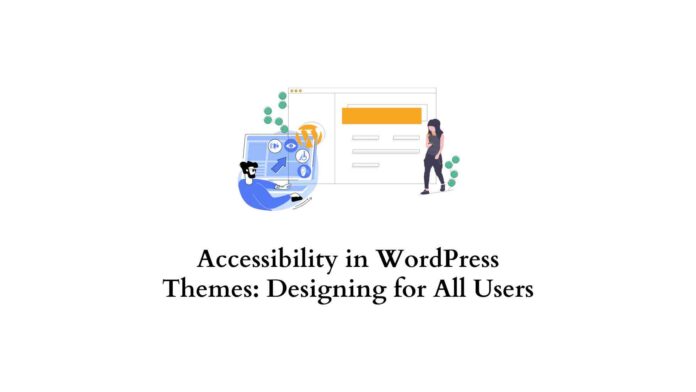Last updated - November 24, 2023
If you want your site to be universally appealing, you need to account for everyone when putting it together. So, let’s go over accessibility in WordPress themes: designing for all users!
Grasping Web Accessibility
Understanding accessibility in WordPress themes is crucial for creating inclusive online experiences. After all, it refers to designing and developing websites that everyone, including people with disabilities, can easily access and navigate. This is not just a matter of compliance since it directly impacts user experience.
Inaccessible websites can exclude a significant portion of the audience, hindering their ability to consume content or make transactions! This is where the importance of incremental improvements shines. And when you’re using WordPress, you can make significant strides in accessibility by utilizing plugins tailored for this purpose.
These plugins address various aspects, from enhancing alt text for images to ensuring proper heading structures. So, the beauty of these tools lies in their ability to integrate seamlessly with your existing WordPress setup. Therefore, whether you’re an experienced developer or just starting, you can contribute to a more accessible web.


Navigating Challenges and Dispelling Myths
Navigating the landscape of accessibility in WordPress themes comes with challenges and misconceptions that need addressing. Dispelling these myths is essential to fostering a more inclusive online environment! While some believe accessible design compromises aesthetics, it’s quite the opposite.
Designers face challenges in balancing creativity with compliance, but accessible design can be both innovative and visually appealing. So, understanding that this type of design doesn’t equate to sacrificing visual allure is pivotal. Collaborative efforts between designers and developers are instrumental in overcoming these challenges.
By working together, they can seamlessly integrate high accessibility standards into the design process! This synergy ensures that accessibility is woven into the very fabric of the website, benefiting all users. So, debunking misconceptions and embracing the design-accessibility balance is fundamental in creating a web space that caters to diverse needs effectively.
Guiding Principles for Accessible Theme Design
Embrace fundamental principles to create an inclusive online environment. Understanding the significance of semantic HTML, structured headings, and meaningful link labels can elevate your design to accommodate diverse users. Moreover, learning how to improve color contrast, font size, and responsiveness is pivotal in ensuring usability for everyone.
These principles are ethical and legally essential to comply with accessibility standards! So, by prioritizing them, you can craft WordPress themes that cater to a wider audience, including those with disabilities. Remember, accessible design doesn’t hinder innovation but enhances it, fostering a more user-centric approach! So, delve into these guiding principles to learn how to improve your theme design and contribute to a web that’s accessible and engaging for all.


Embracing Assistive Technologies and Compatibility
Embracing assistive technologies and ensuring compatibility is at the heart of creating an accessible web. For example, introducing users to screen readers, voice commands, and magnification tools can empower those with disabilities to engage with your content seamlessly.
So, understanding the necessity of compatibility between your design and these tools is key. This compatibility enhances the overall user experience and demonstrates your commitment to inclusivity! Remember, too, that testing methodologies play a significant role in ensuring positive results.
Regular testing with various assistive devices helps identify and address any potential barriers! By embracing assistive technologies and prioritizing compatibility, you’re expanding your website’s reach and fostering a more inclusive digital space for all users. So, dive into these practices to truly embody accessibility in your web design journey.
Putting Users First Through an Inclusive Design Approach
An inclusive design approach places users at the core, catering to diverse abilities and needs. So, prioritizing user-centric practices, such as considering various disabilities during the design phase, fosters an environment of empathy.
Moreover, you refine your design by integrating user testing and iterative feedback, ensuring it’s accessible and intuitive. Inclusivity also entails acknowledging that accessibility isn’t an afterthought and is integral from the outset. So, the inclusive design approach isn’t just about checkboxes; it’s about crafting digital spaces that welcome everyone.
You should embrace this approach and witness not only better accessibility but also enhanced user satisfaction and engagement!
Equipping Developers With Resources and Tools
Empowering developers with the right resources and tools is pivotal in creating accessible websites. Curating a selection of plugins, guides, and accessibility checklists equips developers with actionable insights. These resources streamline the implementation of accessible design principles, ensuring compliance with standards, and incorporating accessibility evaluation tools and plugins aid in identifying and rectifying issues throughout the development process.
To enhance user experience, you should even consider using website performance monitoring tools so you can adjust your approach on the fly! Such tools enable you to track loading times, responsiveness, and overall user interactions, contributing to a seamless experience for all. With these resources and tools in hand, developers can embrace accessibility effortlessly, fostering a web environment that’s welcoming and usable for everyone!
Collaboration Between Designers and Developers
Collaboration between designers and developers is the cornerstone of effective, accessible web design. Seamless teamwork allows for the integration of accessibility considerations from the outset, creating a harmonious balance between aesthetics and usability. Involving accessibility experts in the design and development process enhances the final product’s inclusivity.
By aligning their expertise, designers and developers can bridge the gap between creative vision and practical implementation! This synergy results in a website that not only looks stunning but also accommodates diverse user needs. Of course, clear communication and structured workflows ensure that accessibility remains a focal point throughout every phase.
So, working collaboratively, designers bring creativity while developers bring technical expertise, and together, they form a dynamic duo that creates an online space accessible to all. The result is a web experience that meets standards and exceeds them, fostering inclusivity and enhancing user engagement.


Staying Updated With Evolving Standards
Staying abreast of ever-evolving accessibility standards is pivotal for maintaining an inclusive digital presence. The dynamic nature of web accessibility demands constant vigilance. So, only regularly updating your knowledge ensures your designs remain aligned with the latest guidelines.
Keeping an eye on updates to the Web Content Accessibility Guidelines (WCAG) is particularly crucial! These updates shape your design choices and demonstrate your commitment to accessibility. Resources and online communities also offer insights into emerging best practices. By staying informed, you can implement changes promptly and effectively.
Evolving standards call for flexible approaches capable of adapting to new challenges and requirements! Embracing these shifts enables you to cater to a wider audience, ensuring your web presence remains accessible to users of all abilities. So, make staying updated a cornerstone of your accessibility strategy and contribute to a web that truly embraces inclusivity.
Inclusive Media and Interactive Elements
Crafting accessible websites extends to media and interactive elements, a crucial consideration for inclusivity. Creating videos with captions and audio descriptions ensures engagement for users with varying abilities, and interactive widgets need keyboard navigation options to guarantee seamless interaction.
Embracing these practices, you enable everyone to participate in your content fully! Moreover, integrating accessible media players and plugins enhances the overall experience. And naturally, user engagement is elevated when content is perceivable and operable by all. So, accessibility isn’t just about design; it’s about creating an environment where everyone can interact meaningfully! Therefore, adopting practices that make media and interactive elements inclusive contributes to a web that caters to diverse users, fostering a more equitable digital landscape.
Investing in the Right Site Improvements
Working on accessibility in WordPress themes and designing for all users will truly allow everyone to enjoy your site. So, do not hesitate to pour resources into this endeavor! Trust that it will pay off quickly, and your customer base will grow.











